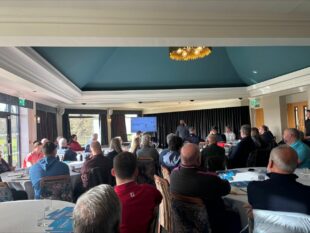The way we play the game is changing and the marketplace is ever evolving. So how can clubs put themselves in the best position to succeed? Craig Higgs, International Managing Director of Golf Genius Software, explains
This article is part of GCMA Insights – topical content for golf industry professionals, discussing the things that matter to those who work in golf clubs.
We wear computers on our wrists more powerful than the rocket that sent Neil Armstrong to the moon. We make payments in supermarkets with the wave of a phone. We buy goods without ever having to walk into a shop.
Technology, and the tools we use to utilise it, is all around us – and it’s becoming an ever more dominant presence in our day-to-day lives.
When it is already determining how we carry out transactions, and how we communicate with each other, it’s only natural that it should play an increasing role in how we spend our leisure time too.
Understanding and being able to assess the ever-evolving golf software landscape is an increasingly important part of a club general manager’s role and that of the committee as well.
Get involved in the debate.
To join the GCMA, click here, or to organise a call with a member of the GCMA team, just complete the form below.
Technology today is about software. Sometimes that software is ‘wrapped in hardware’, such as a smartphone or a moisture sensor. Sometimes it’s a software product, such as a reservation system.
But it’s useful to think of all this technology as software. Why has that computer technology exploded over the last half a century?
It’s because it improves productivity. It allows management and employees to rid themselves of relatively mundane tasks and focus on more high value activities.
In a private club, that means delivering better services to members at lower cost and spending more time interacting with them.
Clubs are ecosystems: a collection of products and services that connect with each other. It’s important for everyone at the club to understand the ecosystem of technology and software that surrounds their daily life and where it can be enhanced for these benefits.Yes, clubs have adopted technology-based solutions. But not at the same rate as other industries.
Some clubs choose to be early adopters of technology, some are fast followers, and some are part of the broad majority that want to be on the leading edge — of the second wave. There is often a conflict between technology adoption and tradition because technology adoption is about change and tradition is about keeping things the same.
But when considering the impacts of technology on a club, the focus should be on culture and not on tradition. Tradition is a carrier for culture, but it’s just one aspect of culture.
In dealing with software suppliers, it is important to place the club in a strong position that maximises flexibility.
This is particularly the case as our world moves very quickly from desktop in-house systems to “cloud-based” systems.
So when clubs are engaging a tech supplier, there are plenty of issues that require consideration. Here are some of the most important:
- Assure that your data is adequately protected and safely stored.
- You own your data, even if it’s in the cloud. This is critically important when the time comes to change suppliers.
- Be very clear on what suppliers can do with your data, particularly member personal identifiable information
- Avoid vendor lock-in
- Insist that your suppliers play well together
- Understand that your software supplier owns its intellectual property, and you are merely using their product
WHY JOIN THE GCMA?
Membership of the GCMA unlocks a network of like-minded professionals, provides you with support in your professional and personal development, and provides you with a multitude of benefits. Whether that’s the tools that will help you to excel in your profession, or a wide range of services to support your wellbeing, signing up to the GCMA is joining a community.
And if clubs are moving forward with implementing software, or are considering subscribing to cloud-based software services, here are some more key points that should be in their thoughts:
- Leverage your members by forming an IT committee of your board. You probably have a lot of expertise from members willing to help – you just need to find them
- Develop a priority list of member-facing systems, backend systems and infrastructure systems
- Develop a sense of how the pieces fit together
- Think cloud. It is happening very, very quickly and delivers numerous benefits. It makes very little sense to own your own servers in today’s world
- Educate yourself about contracting for IT products and services. Otherwise, your suppliers will have a big advantage
- Help your board think through your club’s approach to member-owned technology – mobile phone and tablet use in the clubhouse, for example – by distinguishing culture from tradition.
- Exploit data to better understand what is happening at your club. Using technology can give you a superior way to analyse your operations.
The rate of innovation in IT is increasing at a furious pace as we move forward to wearable computers and sensor-based systems. More and more of today’s club members are those 30-somethings who are completely comfortable with technology and strongly prefer self-service systems.
They are not the future. They are the present and they will only grow in numbers with every passing month, year, and decade. Clubs need to start focusing on their needs. And they need to do so now.
To learn more about Golf Genius, visit their website.
This article is part of GCMA Insights – topical content for golf industry professionals, discussing the things that matter to those who work in golf clubs.
Get involved in the debate. To join the GCMA, click here, or to organise a call with a member of the GCMA team, just complete this form and we’ll be in touch!
Enquiries
"*" indicates required fields



